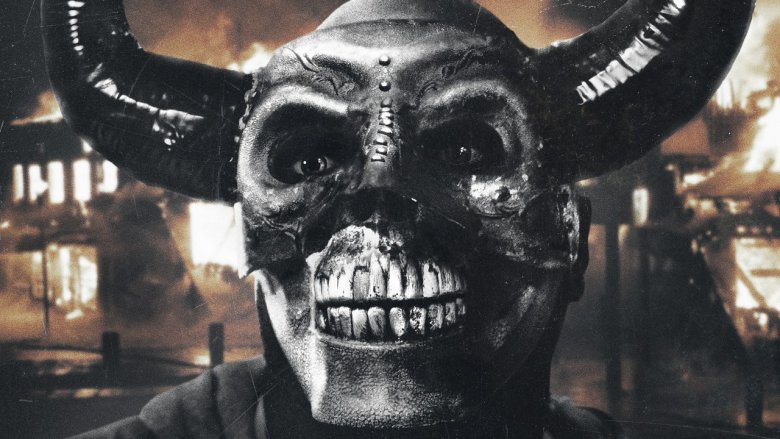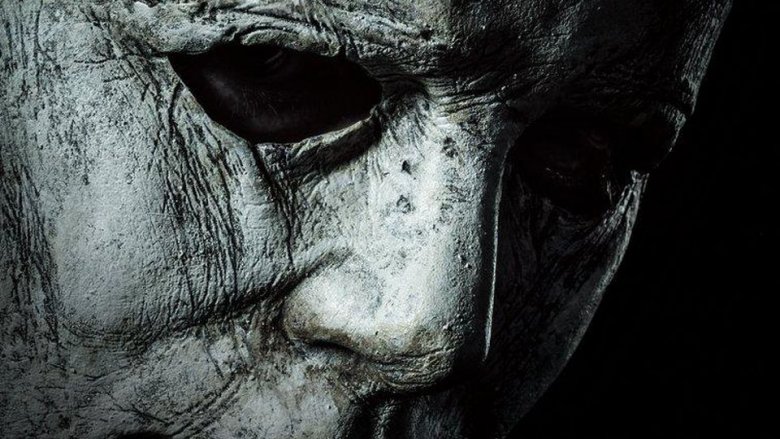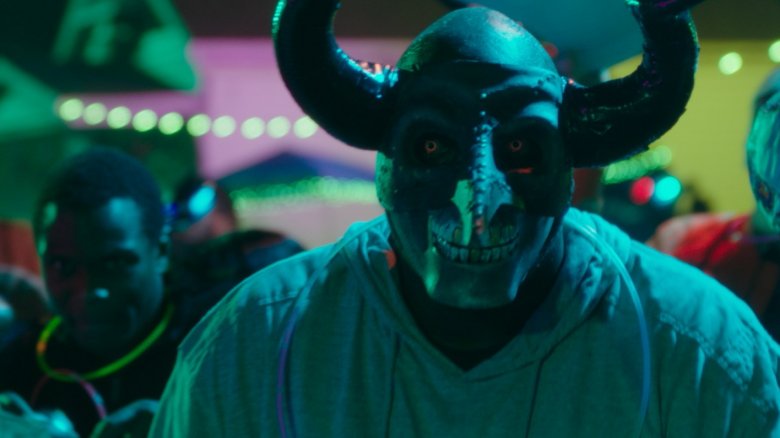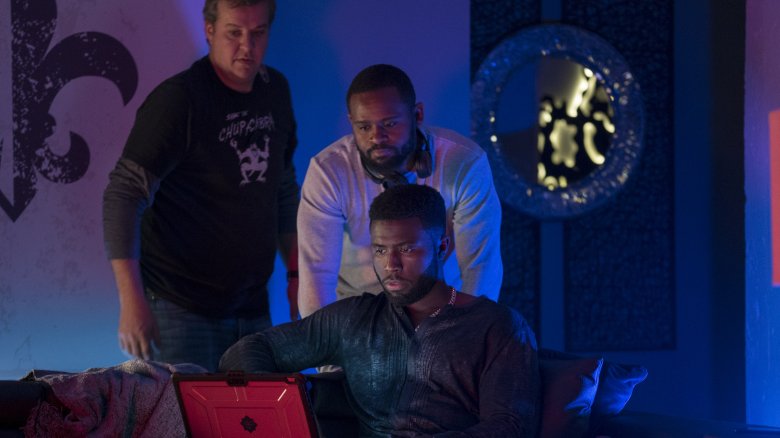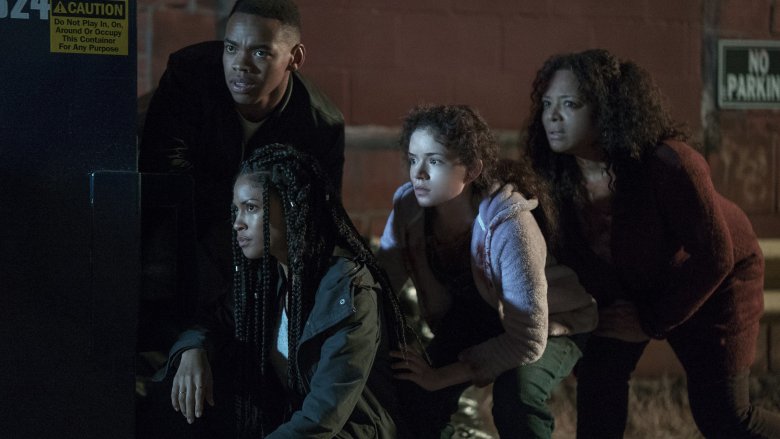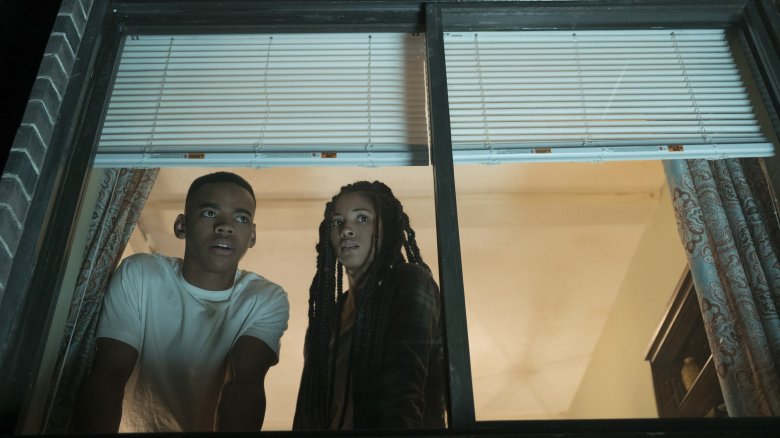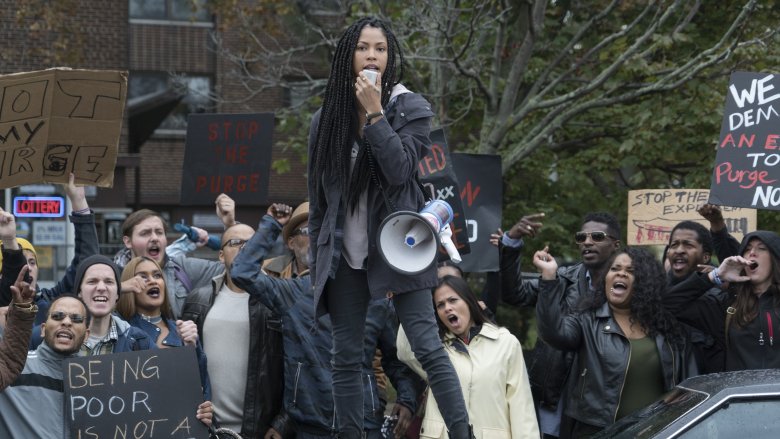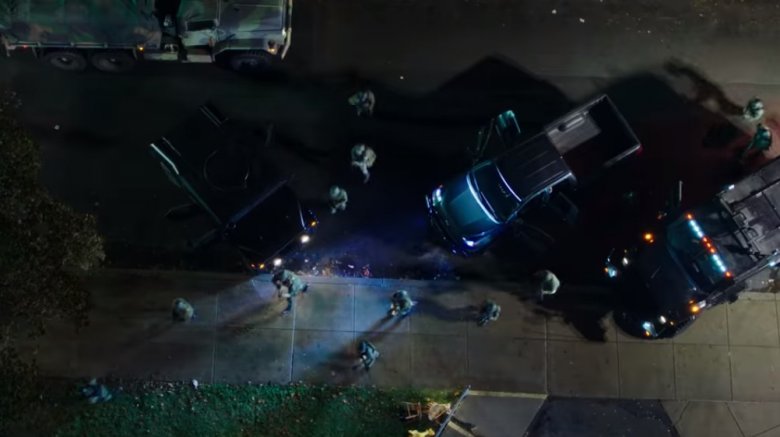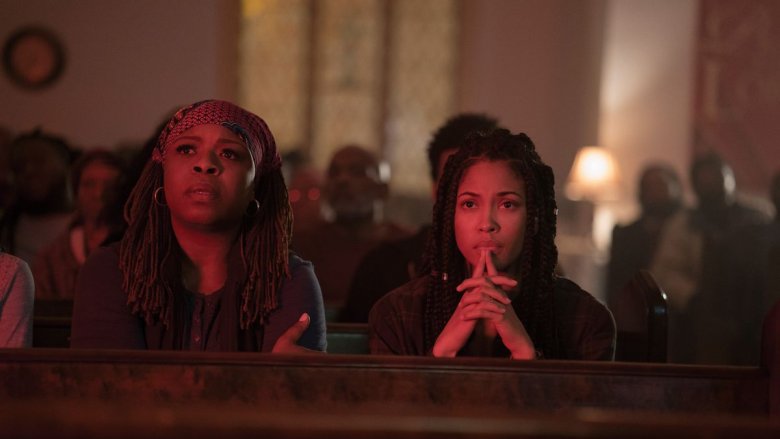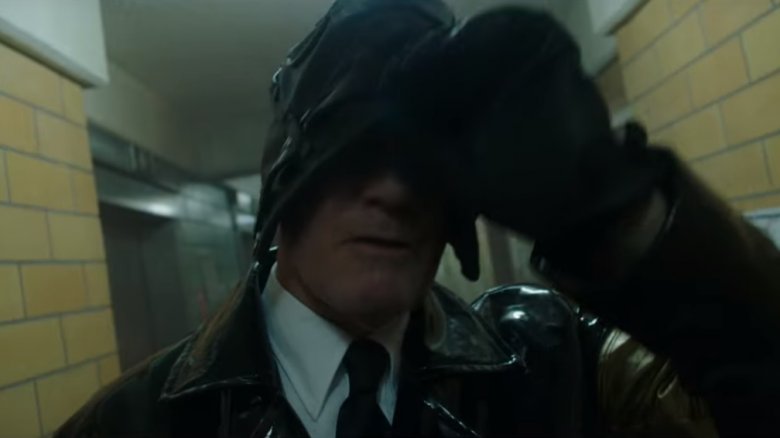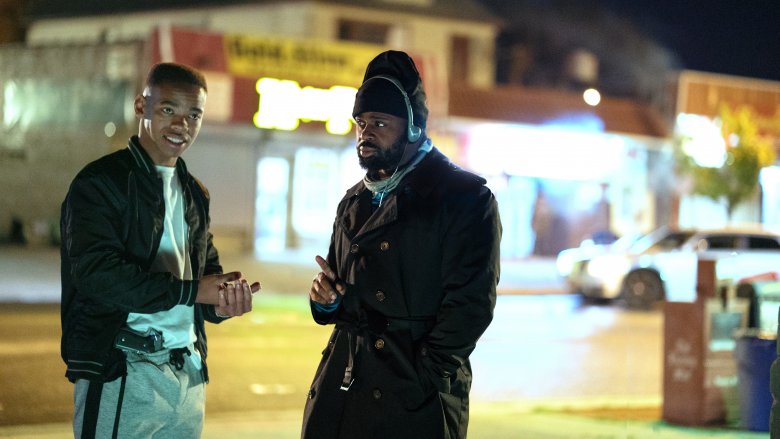Small Details You Missed In The First Purge
Love it or hate it, The First Purge is not a subtle movie. The fourth film in the allegorical The Purge franchise, this prequel story gets right to the heart of some weighty themes that the series has been playing with for years now. Directed by Gerard McMurray (rather than series creator James DeMonaco, who headed up the first three Purge movies), The First Purge seems designed to shine a spotlight on issues of white supremacy, systemic racism, the abuse of the lower classes, and resurgent Nazism — and it really rubs your face in it, whether you like it or not. Taken as a whole, it's hardly a divisive message — unless you happen to be sympathetic to the hyper-conservative bad guys this movie is loudly banging the drum about. In that case, it might come off as a little hostile.
If you look past the somewhat obvious first layer of symbolism in the movie, with the red, white and blue KKK hoods, the torches, and the iron crosses, you'll find a film dense with symbolism all the way down to its core. All throughout its runtime, the movie sends little subliminal messages to the viewer, rewarding close viewing — which is one of the reasons this exploitation-style horror-thriller might be the best entry in the whole series. Whether you've seen the movie already or are thinking of checking it out, here are some little details about The First Purge that you might not catch at first glance.
Coming this October
One of the most self-serving small details in The First Purge is a reference to another movie from Blumhouse Productions coming out in 2018: The sequel to John Carpenter's Halloween. Specifically, we're talking about the first movie poster released for the new Halloween, dominated by the eerie blankness of Michael Myers' mask. The one-sheet can be seen in Isaiah's room in the Park Hill tower, pasted conspicuously to the wall. With both movies being produced by the same studio and The First Purge arriving three months before the release of Halloween, it's an undeniably corny bit of self-referential pseudo-humor, an inside joke that also works as an advertisement. (It also contradicts the series' own history, which previously had the Purge being established in 2017. Oops?)
As a franchise, The Purge movies have always played fast and loose when it comes to their setting. Promotional materials from years past seemed to place the first movie in 2023, but for the most part, the movies have kept the goalposts moving, feeling like they're taking place some "20 minutes into the future." Thanks to this conveniently-visible Halloween poster (emphasized in multiple scenes, no less), we now have to suppose that the experimental first Purge doesn't take place until at least Thursday, April 19, 2018 — the date those posters were revealed.
Peaceful Purge
While the Purge becomes a nationally-celebrated institution and bona fide holiday by the time of the first three movies, The First Purge demonstrates that that shift toward carnal violence didn't happen overnight. It's somewhat encouraging!
One of the recurring premises of the series has been that the government of the New Founding Fathers of America has to seriously juke the stats and put on pressure to ensure maximum carnage on Purge Night. While the Purge is portrayed through propaganda as being a cleansing ritual beloved by all citizens, the prequel movie demonstrates how, in the beginning, almost no regular people seemed to want the Purge at all.
The First Purge gives its best indication of this pacifist tendency during the outdoor block party scene, a drunk and drugged-out bacchanal that's less the first Purge and more the first Burning Man. Nothing violent happens until someone who's being paid to purge shows up and starts slicing, instantly killing the vibe and clearing the streets of people. In the backdrop of the party during this madness, you can spy a large peace sign arranged on a fence with Christmas lights, an indicator that things would have probably been quite peachy for Staten Island, if the government had kept its money and militias out of things. Again, it's not a subtle message. You let the people govern themselves, and you've got yourself a pretty radical party. You get money involved, though? That's when people start getting killed.
Bathed in blue
Director Gerard McMurray doesn't light The First Purge in a particularly realistic way. To set the movie's mood, the filmmaker deploys a recurring blue motif — and once you start looking for it, you see it everywhere.
The blue color can be found in the political materials for the New Founding Fathers of America, coloring their pins, flags, and campaign signs. As the party brings the Purge to Staten Island, the color asserts itself across the population. Dmitri's apartment, where he's eventually attacked, is an exaggerated color of blue. Isaiah, preparing to participate in the Purge out of financial necessity, is framed against completely blue walls, in blue light, as he prepares to head out for the night. (His livestreaming contact lenses that he wears are also bright blue, meaning the color doesn't just surround him — it invades him.)
Further, mercenaries who attack the island wear blue bandannas or blue hoodies. The implication is that the blue represents the Purge itself, surrounding the movie's protagonists and asserting its presence over them. Of course, blue is also the color of the flowers that have become, by the first movie, a symbol of support for the Purge tradition. There is a small sign of hope, though, in the painting in Dmitri's office, where a blue-gloved boxer is seen being punched out by a red-gloved boxer — a somewhat encouraging metaphor, even if it takes a while to come true.
Grabby, handsy sewer guy
While many of The First Purge's participants aren't at first inclined toward murder, there are a good few creeps in the mix pouncing on the opportunity to commit some heinous, less-lethal crimes. When Nya runs through the empty back alleys of Staten Island, her foot is caught in a rope snare, which jerks her down to the ground. A grabby, monstrous man lurking beneath a grate in the ground then starts pawing his way up Nya's legs in a scene that — like a lot of violent acts in the movie — kind of just goes on for too long. Nya turns the tables on the attacker and manages to sprint away, shouting something back that probably sounded familiar to anyone paying attention to politics in 2016.
It's not the sort of thing you necessarily notice in the moment, but the line — which seems to have been added in via ADR, with Nya facing away from the camera as she shouts — is a clear callback to a notorious quote from Donald J. Trump, the Apprentice guy and 45th president of these United States. What's the purpose of the reference here? Well, that remains unclear. If you can knock The First Purge for anything, it's that it doesn't deploy all its pointed commentary all that gracefully.
The savior
Nya, the capable protagonist played by Lex Scott Davis, is one of the most heroic figures The First Purge has to offer. Throughout the movie, she acts selflessly, protecting others to the point of being comically brash. She goes out in public well after the experiment starts to find and help Isaiah when purging for pay becomes too real for him.
But before that desperate bid to rescue her brother, she uses the hours leading up to the experiment to corral as many people as possible into a church to wait out the experiment. Ultimately, thanks to the island invaders (who are either literally the Ku Klux Klan or, uh, big fans), most of the people in the church don't make it out alive. But Nya tried, and the movie constantly frames her as a savior figure, frequently positioning her right next to drawings of crosses or actual crosses in the frame. It's a subliminal way of letting the audience know that this girl is basically a saint, and an ally well worth trusting.
The 28th
During the protest scene taking place outside of the Park Hill housing project, a sign can be seen which reads "The 28th is a hate crime" — "28th" referring to a 28th Amendment, which has previously been referred to in the series as the Constitutional amendment that established a "yearly right to purge."
Prior to the release of The First Purge, this amendment idea made the most sense as an explanation for how such a sweeping societal change could be imposed upon the American population. But when you really think about things now that The First Purge is in the series mix, this timeline doesn't make any sense at all. The text of the amendment itself is exactingly specific about what it's for, officially codifying a right to purge on a specific date. But does this protest sign mean the amendment was passed before an experimental purge was ever conducted? Doesn't that seem like it'd be way, way too late to usefully test the concept? This is either a plot hole or a dumb political strategy. Either way, we're starting to think that these New Founding Fathers don't know what they're doing.
Aryans in disguise?
One of the grossest scenes in The First Purge takes place as Dmitri stages his one-man counteroffensive against the militia in the housing tower. And we mean gross in every way — not only does he kill one soldier with a brutal choking that the camera lingers on, but the soldier he's killing is wearing a horrible blackface balaclava.
The shot of the death squad member getting the life strangled out of him in close-up isn't a great one to look at, so maybe you busied yourself in your box of Milk Duds as the fatal encounter played out. You might have missed the detail that beneath the mask, the professional purger is revealed to have blond hair and blue eyes. It's a case of pretty deliberate casting, considering that that particular look is the classic profile of Adolf Hitler's ideal Aryan — his supposed master race.
Ever since the first Purge movie, the James DeMonaco-created series has been pulling the looks of its antagonists from right-wing schools of thought. In The Purge, the main villains terrorizing the Sandin family have a decidedly preppy, Young Republican sort of look to them, all sweater vests and suits and ties. But while the early Purge movies were only heavily implying some right-wing aspect to the horror, The First Purge just goes all the way with it and makes its bad guys openly hateful, racist, literal Nazis.
Pray not purge
As the experimental first Purge approaches, many gather in a Staten Island church, teaming up for shelter as they wait the night out. It turns out, of course, to be a tragically, almost naively under-defended location, not standing a chance as an actual sanctuary once the NFFA's merciless hired militia shows up. But for a while, it's the closest thing the characters have to a home base.
Like many real-life churches, the proprietors of this house of worship took some time to comment on current affairs with their illuminated sign, posting up a message that reads "Pray Not Purge, Galatians 5:16."
The actual verse that the movie is referring to doesn't get too specific about the movie. (Unlike our personal, apocryphal commandment of "Thou shalt not purge without Frank Grillo, lest ye die defenseless".) Instead, what the actual verse says is, according to the King James translation of the Bible, "Walk in the Spirit, and ye shall not fulfill the lust of the flesh."
It reinforces a theme that recurs throughout the movie, of people having the option to purge, and choosing not to do it. For the most part, the movie's only bad guys are the people coerced by money to participate more fully in the experiment, and the agents of the government sent to do some heavy lifting. Everyone else tries to survive, not kill. So although this movie is brutal, it does have a somewhat hopeful disposition.
Blitzkrieg to boardroom
The ultimate antagonists of The First Purge, following the KKK invasion, are the members of the Nazi-esque death squad climbing the Park Hill housing project towers, executing its inhabitants room-by-room. And we don't just say "Nazi-esque" because they goosestep a little when they walk. No, the movie directly refers to the Third Reich in its costuming, giving the kill squad's leader a full-on, intimidating SS outfit, with a gold armband on his left arm right where the Nazis used to wear theirs.
Dressed in a shiny, vinyl-looking black greatcoat with his face obscured, this ruthless Darth David Duke is sort of the movie's final boss, stalking the hallways of the housing project and directing his men toward slaughter. There's no passion to him — just purpose.
As the movie nears its end, the group's leader begins to strip away his slick greatcoat and other SS-esque trappings, discarding articles of clothing before the final confrontation until he's just wearing a put-together business suit with a white button-down. Why does he do this in the thick of a gunfight? Well, for symbolism's sake, of course. Could the movie be saying that the Nazi general of yesterday is the square-jawed businessman of today?
The most obvious explanation is that this antagonist represents "the Man," standing in for systemic forces that keep lower classes and other undesirables down in the NFFA's government. Sometimes a genocidal mission of exploitation and destruction is explicit, a la the Nazis — and sometimes it's just business.
To the five boroughs?
While The First Purge shapes its identity entirely around the geographically-isolated Staten Island, it wasn't actually shot in that location. Despite a few conspicuous signs for actual local streets that seem to place the movie on the island, the movie was mostly shot on the mainland. Rather than New York City, the movie was primarily filmed in upstate New York, specifically Buffalo.
It's a common thing for movies to be filmed in completely different places from where the stories are set, but considering that the fourth Purge movie is heavily identified with Staten Island — at one point reportedly being called The Purge: The Island — the fact that it's being filmed somewhere else is something your brain might not be able to help but notice.
"Buffalo had to replicate Staten Island and it did," director Gerard McMurray told Buffalo News. "Buffalo tapped into a sense of Staten Island that worked to tell the story. The locations were fantastic. All the nooks and crannies we found — they were spot on and helped me tell the story I wanted to tell."
One of the locations the production chose for its "authentic and isolated" qualities was right in the neighborhood of an active General Mills plant, which was apparently in the process of producing Cheerios en masse during the nights they shot.
"The smell — they smelled so good," McMurray said. "We smelled Cheerios at 3 or 4 o'clock in the morning and it kept me up."
